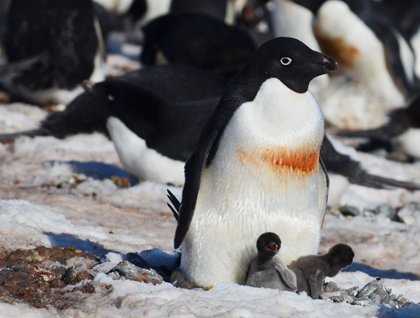One of the first things we saw when we looked out our windows this morning was the beautiful sight of porpoising Adélie penguins. Effortlessly gliding above and below the water, creating beautiful black and white arcs, we came to realize firsthand why the naturalists say penguins can fly underwater. Penguins have developed this swimming ability so that they can travel quickly without having to stop to breathe. Although we had observed this behavior briefly with the chinstrap and gentoo penguins, the Adélies gave us a real spectacle all around our ship and landing site.
Early in the morning, we landed at Brown Bluff to find striking volcanic formations. Some of us chose to hike along the glacier, while others made their way toward the Adélie penguin colony. We felt overwhelmed to witness the sheer number in this colony, up to 20,000 breeding pairs, whose young were beginning to hatch. As one adult would porpoise their way out into the sea, the other would nestle the tiny, downy chicks. Adélies often lay two eggs, and we saw many different stages of hatching. The naturalists informed us that only about 60% of these chicks will survive until adulthood, and we witnessed this food chain in action, seeing kelp gulls swoop in to grab a chick, and a leopard seal far off in the distance picking off the adult penguins returning with krill. They were so mesmerizing that we could have stayed to watch them porpoise and nest all day, but alas, we had places to go and icebergs to see!
A definite highlight of the day was having a close up view of the magnificent tabular icebergs as we cruised through the eastern edge of the Antarctica Peninsula in the Weddell Sea. These large flat, tabletop icebergs are located only in Antarctica. This type of iceberg is an extension of the ice shelf from the continent and is an accumulation of compressed snow and ice, which is floating on the sea. One can’t help but observe in awe, the striations, sculpted formations and striking color patterns of the ice. Normally we see ice as white because all the colors of the spectrum are reflected in the air in the ice, however these large bergs often appear blue because older ice has experienced more pressure, and therefore, has fewer air bubbles. After calving, erosion can cause the stripes of an iceberg to become asymmetrical and produce stunning exteriors. As they move around the seawater by surges of water from the tides, they become sculpted by this action. Many of the pieces we observed were broken off of the B15 iceberg, which broke off the Ross Sea, ice shelf in 2001.
We couldn’t have chosen a better way to spend our final landing day, and we feel honored to have been a part of it. It helped increase our understanding and appreciation of this stunning wilderness. We look forward to more sights and engaging learning with our naturalists as we journey home!






